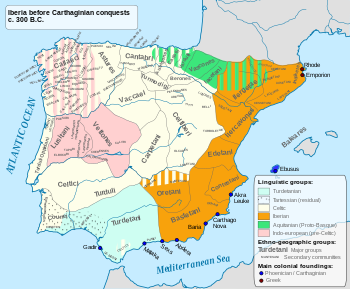
The Lady of Baza is a famous example of Iberian sculpture by the Bastetani. It is a limestone female figure with traces of painted detail in a stuccoed surface. It is held in Spain's National Archaeological Museum.

The Vettones were an Iron Age pre-Roman people of the Iberian Peninsula.

The Turduli or Turtuli were an ancient pre-Roman people of the southwestern Iberian Peninsula.

The Ausetani were an ancient Iberian (pre-Roman) people of the Iberian Peninsula. They are believed to have spoken the Iberian language. They lived in the eponymous region of Ausona and gave their name to the Roman city of Ausa.

The Ilergetes were an ancient Iberian (Pre-Roman) people of the Iberian Peninsula who dwelt in the plains area of the rivers Segre and Cinca towards Iberus (Ebro) river, and in and around Ilerda/Iltrida, present-day Lleida/Lérida. They are believed to have spoken the Iberian language.

The Indigetes were an ancient Iberian (Pre-Roman) people of the eastern side of the Iberian Peninsula. They are believed to have spoken the Iberian language.

The Laietani were an ancient Iberian (Pre-Roman) people of the Iberian Peninsula. They inhabited the area occupied by the city of Barcelona. One of the main thoroughfares of the city, Via Laietana, is named after the Laietani. They are believed to have spoken an Iberian language.

The Cessetani were an ancient Iberian (Pre-Roman) people of the Iberian peninsula. They are believed to have spoken the Iberian language. Their territory extended along the coast between the Coll de Balaguer and the Garraf Massif and was limited in the west by the Prades Mountains.

The Ilercavones were an ancient Iberian (Pre-Roman) people of the Iberian peninsula. They are believed to have spoken an Iberian language.

The Oretani or Oretanii were a pre-Roman ancient Iberian people of the Iberian Peninsula, that lived in northeastern Andalusia, in the upper Baetis (Guadalquivir) river valley, eastern Marianus Mons, and the southern area of present-day La Mancha.

The Edetani were an ancient Iberian (Pre-Roman) people of the Iberian peninsula. They are believed to have spoken a form of the Iberian language.

Contestani is an ethnonym of Roman Spain of the imperial period. It appears chiefly in the Greco-Roman writers Pliny the Elder, 1st century, and Claudius Ptolemy, 2nd century. Pliny might be considered the more creditable, as he was for a time procurator of the official Hispania Tarraconensis, a province of the Roman Empire encompassing all the north and all the east of the Iberian Peninsula.

The Lusones were an ancient Celtiberian (Pre-Roman) people of the Iberian Peninsula, who lived in the high Tajuña River valley, northeast of Guadalajara. They were eliminated by the Romans as a significant threat in the end of the 2nd century BC.

The Lacetani were an ancient Iberian (pre-Roman) people of the Iberian Peninsula. They are believed to have spoken an Iberian language.

The Lobetani, were a small pre-Roman Iberian people of ancient Spain mentioned only once by Ptolemy in the 2nd century AD, situated around the mountainous Albarracín area of the southwest Province of Teruel.

The Germani were an obscure pre-Roman ancient people of the Iberian Peninsula which settled around the 4th century BC in western Oretania, an ancient region corresponding to the south of Ciudad Real and the eastern tip of Badajoz provinces.

The Sedetani were an ancient Iberian (Pre-Roman) people of the Iberian Peninsula. They are believed to have spoken a form of the Iberian language.

The Cerretani or Ceretani were an ancient pre-Roman people of the Iberian Peninsula who occupied what became the modern-day Cerdanya, in the valley Segre and part of Aragon. Their neighbours from the east were Ausetani and from the south Ilergetes. Their capital was Julia Libyca, modern Llívia. They are noted in Greek and Roman geographical treatises.

The Castellani or 'Castelani' were an ancient Iberian or Pre-Roman people of the Iberian Peninsula. They inhabited the bottom of the eastern Pyrenees in the northern Tarraconense.

The Bergistani, were an ancient Iberian or Pre-Roman people of the Iberian Peninsula. They were related to the Ilergetes and were not numerous. They inhabited the valley of the Saiarra river in the upper course of the Llobregat in the northern Tarraconense.






